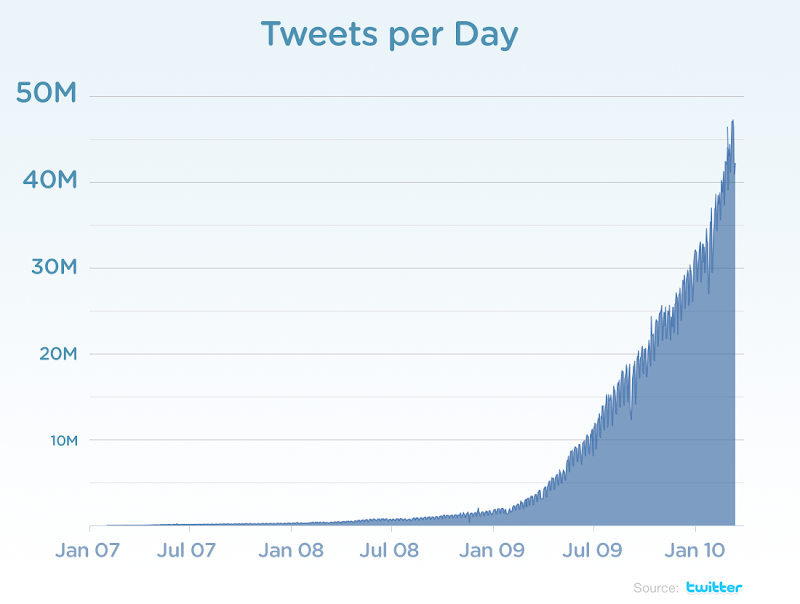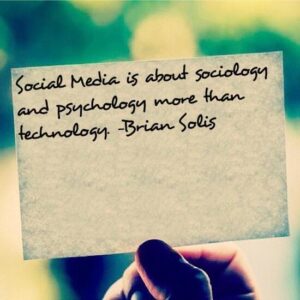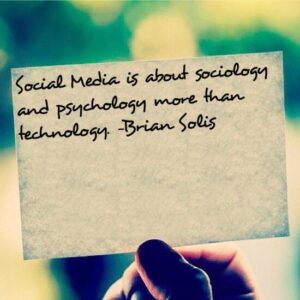
The fascination with Twitter has less to do with the number of users and everything to do with the ability to observe and study a notable online community of passionate short-form content creators and consumers. This is of course, not just any online community. Twitter is quickly becoming the lens into all that moves us as individuals and also as a global society.
Twitter’s simplicity is part of its brilliance. The ability to interpret, analyze and in turn, predict behavior, currently sets it apart from most other social networks. Twitter has become a human seismograph, measuring and broadcasting the pulse of not just the Web, but also world and local events. News no longer breaks, it Tweets. And if you’re plugged-in to the human seismograph, you are part of a movement, one that defines trends and distributes information before the rest of the reverberations are felt across the rest of the world. You become part of the new information system.
In many ways, Twitter’s openness creates a new genre of digital anthropologists, sociologists and ethnographers. Twitter users reveal the state of all things captivating attention and inspiring action, all in real-time. As new found social scientists, we learn everything. Most notably, we can pinpoint how Twitter, as well as Facebook, is transforming popular culture and the behavior that defines it.
In every stone that shapes the Twitter monolith is a bit of each one of us. We, as individuals, bring to it the very essence and sustenance that brings Twitter to life. We are its denizens. We are its ambassadors. We are the keepers of the Twitter commonwealth.
There is empowerment to Twitter that is unlike that of any other social network. Perhaps, that’s why it lends to a unique social egosystem, but similarly, there are stages of personal growth that unfold with every Tweet we publish, each response or RT we engender, and every follower we earn.
I Tweet, therefore I am.
For many who have yet to grasp Twitter’s promise, you’re not alone. Twitter, as a company, doesn’t necessarily make it easy to embrace nor fathom. Yes, Twitter recognizes that the incentives for new users to join Twitter as well as the initial experiences or lack thereof are now indicative of its position in the technology bell curve of adoption. As it moves toward mainstream awareness and adoption, the motivators for willfully adapting one’s lifestyle is unique to this stage of change evaluation and is not at all similar to those early adopters who initially propelled Twitter into the statusphere.
As detailed studies emerge that dissect Twitter’s migration from relevance to omnipresence, we gain the insight necessary to comprehend its effects on humanity.
One such study recently captured and articulated that State of Twitter in the U.S. Edison Research and Arbitron Internet recently surveyed 1,753 Americans age 12 and over to peel back the layers of fervor and hype to reveal the very people using Twitter and defining a new era of communication.
Awareness
According to Edison, Twitter’s awareness exploded from 5% in 2008 to 26% in 2009 to near ubiquity at 87% in 2010. Of course this is due in large part to our near rabid obsession with the service in mainstream media, businesses, even local shops and services, incessant advertising of Twitter through front-facing pleas, “follow us on Twitter!”

If metrics provide a baseline for appreciating Twitter’s rapid journey to recognition, the study compared Twitter’s stature to one of the largest social networks in the world.

Twitter is becoming a household brand, it just now has to work towards earning a position as a household service, something Facebook is currently reveling. At almost equal recognition levels, Twitter trails Facebook in actual usage by a staggering 34%.

Twitter Usage
Twitter recently hosted Chirp, its first conference where it revealed that it hosted over 105 million registered users. According to Arbitron and Edison, Twitter usage currently stands at an estimated 17 million Americans.

Twitter Activity Secrets Revealed
Twitter recently announced users were Tweeting upwards of 50 million times per day at an average rate of 600 Tweets per second.

Previous studies have shown that a small percentage of the overall user base is responsible for the greater volume of total Tweets. In the new Arbitron and Edison report, we’re introduced to five specific segments of “Tweeters” (I’ll name them to make it easier for future reference):
– Broadcasters (Several times per day)
– Commentators (At least 1x per day)
– Contributor (at least 1x per week)
– Neutral (At least 1x per month)
– Inactives (Less than 1x per month)

Twitter Demographics
While the following demographics reveal the segments of people using Twitter, as marketers, business professionals, and brand managers, pay closer attention to the “interest graphs” interwoven within the network. It’s how Twitter is basing its advertising architecture and its focus on psychographics over demographics is aligned with the dynamics of social media in general.
In the “Age of Social Networks,” the average age of a Twitter user was revealed as 39. Now we learn that 38% of Twitter users are age 35 and older with the greatest concentration of users falling between 25 to 34. And, as we already know, in Twitter, Social Media, and now mobile social networking, women rule.

Examining the composition of ethnicity in Twitter brings to life the richness of diversity, but also its assemblage of core groups, mainly White, African American and Hispanic.

Twitter Users are $chooled
Education and income levels naturally factor into the focus and segmentation of how businesses connect with distinct markets. For some, the desire to reach educated individuals with greater levels of discretionary income is paramount. It seems that Twitter is a network that caters to the well-educated as well as those with higher household incomes.


Twitter is a Mobile Experience
One in four users actively access Facebook from mobile devices. That equates to roughly 100 million users, which is for the time being, far greater than the total number of all Twitter inhabitants. Perhaps it’s part of the engineered simplicity. Whereas 25% of Facebook users are mobile, almost two-thirds of Twitter users are comfortable accessing the service via their mobile phone – thanks in large part to the brilliant array of third-party applications available by popular developers.

Twitter is an Exchange for Products and Services
For companies seeking to engage prospects, customers, and influencers in Social Media, Twitter is a goldmine. 42% stated they wish to learn about products and services and 41% already provide opinions about them. Many updates in Twitter related to products/services are indeed questions about experiences. 31% of those polled admit to asking for user opinions. Here’s where businesses also need to pay attention. 28% of users polled are seeking discounts and offers. 21% claim to purchase products and at the moment, 19% are taking to Twitter to seek support.

If You Tweet Away, I Will Follow…
For businesses looking to engage in the conversation, Twitter is proving to be a means to connect the dots. For those brands that can effectively listen, respond, and also spark clicks to action, they will weave a rich network of invaluable touchpoints for customer acquisition and retention. According to the survey, Twitters users are more than likely to follow brands in companies at profound levels when compared to other social networks. In Twitter, 51% responded yes whereas 84% responded no when compared to all social network users.

And So It Continues…
To leave you with one last point intended to convey the preponderance of social networks. The adoption of social networks is soaring across every demographic at a minimum of 10% with some as high as over 20% between 2009 and 2010 alone. Don’t expect that steep incline to taper any time soon.

Connect with Brian Solis on Twitter, LinkedIn, Tumblr, Google Buzz, Facebook
—
Please consider reading my new book, Engage!
—
Get Putting the Public Back in Public Relations and The Conversation Prism:


—
Image Credit: Shutterstock






Wow it is surprising to see all these figures, stats and charts organized this way. But I agree when you say that even with all these incredible facts shown in this way, the basis of Twitter success is in its simplicity and direct communication approach.
Great post.
Wow it is surprising to see all these figures, stats and charts organized this way. But I agree when you say that even with all these incredible facts shown in this way, the basis of Twitter success is in its simplicity and direct communication approach.
Great post.
Whoa there Brian, that's a heckuva lotta charts. My presentation viewgraph filters have blinded me to the second half of the stats you showed (of which I've seen quite a few before on other posts).
Is twitter so fundamentally different from Facebook that's it's really an alternative social web network, or just another central attention taxing system wearing a different suit?
Really great mix of graphs and analysis as always. I think the Edison research is fascinating, especially the difference between awareness / usage between Twitter and Facebook.
Once again Brian, great stats! I'm kind of a graph/stat junkie so anytime someone puts together an extensive post like this, I can't help but read it all the way through 🙂
Have a great weekend man!
Interesting. How are you determining sex? That's not filled out during the the application process. Neither do you fill out “education level”. Huhm. How did you compile that information? These might just be guesses…
Yes good work on this pulling the records in charts and graphs, i too like this way of information
Brian..thanks for dragging this together. A lot of data..felt for a second like I was going over my slides for a board presentation 😉
Seriously, this info is from the user side. Working with a number of client building channels on the corporate side out to customers and looking for innovative and/or measurable case studies. Any URLs you can point me to?
I just don't get it. Though I am a bit of a tech geek, I don't get the power of this phenomenon. Can someone please explain how Twitter can enlighten my life?
RJMetrics Inc. reckons that Twitter had 75million global users, as of January 2010. That's around 1.1 per cent of the global population – take away inactive profiles, spammers and automated accounts for new services and blogs and I reckon you'd be lucky to have 0.2 per cent of the global population represented on Twitter.
Yes, adoption has been phenomenal and Twitter and its users have influence but to say that 'Twitter users reveal the state of all things captivating attention and inspiring action, all in real-time…we learn everything' is a rather enormous over-statement.
Lets keep things in perspective.
I think this is an awesome piece and thank you Brian; as a lawyer in private practice, the profession has an adoption rate viz social media that has yet to break the 2% mark. I am a huge fan of Twitter and its power to spead a message quickly and attract masses of attention. It is a great shame that the legal profession has yet to realise its vast potential to do good (for their practice) and is holding back, presumably, because of the risk.
Thanks for the detailed analysis of the state of Twitter. Just had a conversation with a business associate last week who didn't see the relevance of Twitter for business. This post certainly will help him see the light!
Thank you for this insight.
I am curious to know whether there are not only demographic user segments but “profession based” user segments. My impression is, that Twitter is better accepted among business professionals, while Facebook also attracts artists (I refer to painters or photographers and have researched this only at my site so far: http://www.staeudtner.com).
Brian, do you see Twitter ever having usage numbers comparable to Facebook? It seems that Twitter's appeal and the behavioral patterns of it's users is more niched than Facebook.
…and have a blast at Cannes!
Great stuff, as always. It will be interesting to see what happens to Twitter when the majority of us carry smartphones. Although a lot of people access Twitter from their phones, I think there will be another evolution as 4G networks emerge and the 'average' person begins to download apps and interact more sharing data on their cell.
Great stuff, as always. It will be interesting to see what happens to Twitter when the majority of us carry smartphones. Although a lot of people access Twitter from their phones, I think there will be another evolution as 4G networks emerge and the 'average' person begins to download apps and interact more sharing data on their cell.
Twitter is definitely more widely known now